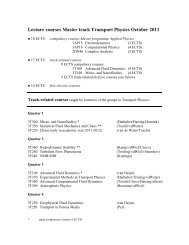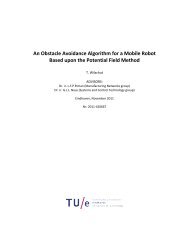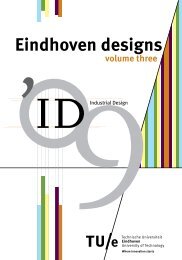Self-evaluation - Technische Universiteit Eindhoven
Self-evaluation - Technische Universiteit Eindhoven
Self-evaluation - Technische Universiteit Eindhoven
You also want an ePaper? Increase the reach of your titles
YUMPU automatically turns print PDFs into web optimized ePapers that Google loves.
Appendices self-<strong>evaluation</strong> research programme ESoE<br />
By now it is a known fact that traditional strategies for educational reform, which are based on the<br />
RDD model, fail to be effective. These strategies are grounded on a chronological succession of<br />
Research, Development and Diffusion (RDD). The starting point is scientific knowledge; this is<br />
converted by developers into useful instructions, and these are distributed among teachers, who, in<br />
turn, apply them consistently. Generally this approach has not proved to be successful. Although this<br />
was initially blamed on the fact that teachers failed to implement the innovation consistently, it is now<br />
thought that the problem lies with the model itself. In the RDD model, teachers’ views, knowledge,<br />
ideas, intentions, and attitudes are not taken sufficiently into account (Van Driel, Beijaard & Verloop,<br />
2001). Educational innovations demand a change in the teachers’ way of thinking. The term<br />
“cognitive change” is also used in this respect. In this way, emphasis shifts from construing and<br />
implementing educational reforms to organizing teachers’ learning as the basis for educational<br />
innovation.<br />
To bring processes of change in motion from outside, teachers will need to be motivated and inspired<br />
to adopt these changes and to give shape to them themselves. In this context, this is referred to as “the<br />
teachers’ own practice as a starting point for professional learning”. Ideally, the latter would take<br />
place in cooperation with colleagues and with the support of experts. A crucial element in favorable<br />
innovative processes is that teachers visit each other’s classrooms and feel jointly responsible for an<br />
ongoing process of educational improvement. Interesting in this respect is the “lesson study” model,<br />
which is currently the vogue in Japan (Stigler & Hiebert, 1999). The starting point of this approach is<br />
that a group of teachers assumes responsibility for working out a reform, or for educational<br />
improvement in general. The common procedure is that the teachers jointly develop a lesson that is<br />
given by one of the group members. The others observe the lesson after which an in-depth discussion<br />
follows, focused on analyzing and improving the lesson but also on considering the lesson in a wider<br />
context of the intended improvement or reform. Subsequently, a new or improved lesson is<br />
developed, which is given by one of the group members, and the cycle repeats itself. The power of the<br />
lesson study model is that it makes educational reform and professionalization an ongoing and<br />
incremental process. Moreover, it correlates with something that Fullan (2006) regards as one of the<br />
essential points for innovation to be successful: feedback on actual changes in the practice within the<br />
teachers’ own class.<br />
Of course, a number of variations on and supplements to this model are possible and desired<br />
- there is no silver bullet that works for everyone. Thus, teachers can also analyze and discuss each<br />
other’s classes, participate in supervised study groups, or conduct research into their own practice.<br />
Mark, however, that although teachers may learn most effectively together with colleagues (through<br />
exchange, feedback, obtaining input, and so forth), input from outside (experts) proves necessary as<br />
well. In this context, the idea of forming networks should also be mentioned, whereby professionals<br />
of different backgrounds collaborate on the improvement of education. In addition, “learning from<br />
and in one’s own teaching practice” can also be fostered by attending workshops or conferences, or<br />
by taking up a study. Moreover, successful progress should meet all sorts of conditions such as<br />
facilities, time, the possibility of sharing knowledge and experiences, and interest shown and support<br />
given by school management, and so on.<br />
1.1.3 LEARNING AND CURRICULAR INNOVATION<br />
The basic premise of the teacher as a professional also has implications for a view of curricular<br />
innovation. One of the consequences is that curricular materials may play a significant role in<br />
curricular reform, but the image of “the teacher solely as the implementer of education developed by<br />
others” does not fit in with this context. In line with the idea of the teacher as a professional, the<br />
teacher rather than the curricular material should carry an educational reform, even if it involves a<br />
renewal of curricular content. In addition to developing insights and materials to create renewed<br />
education, curriculum developers and researchers should also focus on strategies and materials that<br />
could facilitate professional learning with a view to curricular reform. Design-oriented research could<br />
play a valuable role in this respect, especially because of the inherent interwovenness of designs and<br />
research and in particular when such research focuses on the development of empirically-grounded<br />
theories on how the new education works. In that case, teachers can regard the outcome of<br />
developmental research as potentially adaptable theories, which they may assess and adapt in their<br />
own teaching practice. In this way, the concept of the teacher as a professional can be justified<br />
63

















